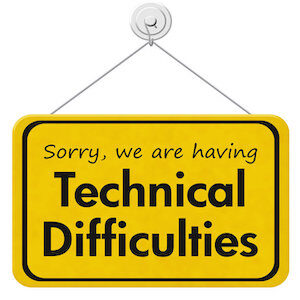By Dr. Ken Broda Bahm:

The persisting pandemic has brought with it more adventures in technology. Courts have seen an increased use of remote testimony and oral argument, and even fully remote trials. When it is done well, it can be surprisingly effective in capturing a lot of the value of the in-person legal process, while also potentially improving access and participation, not to mention reducing the risks of coronavirus transmission. But when there are glitches, it can be frustrating. It is not just a matter of comprehension, and whether we are able to understand the testimony or argument. While a judge might say that, as long as content is understandable, then the occasional freeze, drop-out, or need to repeat yourself won’t matter. If the audio and video are out of sync, if there’s an echo, or if there is too much or not enough volume, we might think that is okay because it is the content that matters.
Unfortunately, that is not the case: Ease of processing matters as well. A group of Australian researchers (Bild et al., 2021) recently demonstrated this in an article in Law and Human Behavior. Study participants heard audio clips of child and adult witness testimony — either a high-quality version that was clear, or a lower-quality version that was understandable, but still hard to follow due to a slight delay that created an echo. In each case, listeners were able to understand the full transcript, but it was simply more difficult in the low-quality version. The researchers found that this matters: “When people heard witnesses present evidence in low-quality audio, they rated the witnesses as less credible, reliable, and trustworthy, had poorer memory for key facts presented by the witness, and weighted witness evidence less in final guilt judgments.” The reason is not due to lost content, but is rather a product of strained or interrupted cognitive processing. As we receive information, we notice whether it is easy or difficult to process, but don’t readily distinguish between difficulty that comes from content and difficulty that comes from the medium or the way it is conveyed. We misread processing difficulty as a problem with the message itself. In this post, I’ll share some thoughts on both the immediate and the broader implications of this finding.
The Immediate Implication: Check Your Tech
Whenever your argument or testimony is going to be live-streamed or recorded, the technology matters. The study shows that this is not just an issue of comprehension, but of credibility and persuasion as well. Even for our now-common Zoom meetings, it is important to factor in the question of how easy it is to follow and process the information. In order to maximize effective communication, check the following:
- Do I have a high-quality microphone?
- Am I the right distance from the microphone?
- Am I avoiding echos or duplicated audio?
- Do I have an environment that minimizes visual and auditory distractions?
- Do I have sufficient internet speed?
- Do I have a high-quality camera?
- Am I appropriately situated in the camera frame?
- Do I have a level camera angle?
- Am I appropriately lit?
- Is there anything else that would create distraction or difficulty?
As the pandemic continues — and the word from Omicron this week is that it’s far from done with us — remote communication will continue to be our bread and butter. Even once it is beaten down to a manageable level of seasonal illness, courts and offices are unlikely to dispense with the efficiencies of at least some remote communications. But the technical details are also critical. Even if the content is possible to follow, but still difficult to follow, the research shows that this comes at a cost when it comes to the influence of your communication.
The Broader Implication: It is About Processing Ease, and Not Just Comprehension
Though the research focused on audio quality, ultimately it is not just a point about technology, it is a point about communication: The more difficult something is to attend to, the less trustworthy it is. The authors note, “Whenever information is difficult to perceive, understand, or imagine, when processing is clunky or strained, recipients evaluate the substantive content of the information more negatively.” So the broader implication, the one that all public communicators and trial advocates should take to heart, is that your content needs to be easy to understand, and anything that makes the audience’s road more difficult is also going to make your message less believable and influential. So, as much as you focus on the evidence and the law, you should also focus on the themes, examples, stories, and visuals. When you simplify and make your information clear and “sticky,” you are also increasing your chances at persuasion.
Other Posts on Trial Technology:
- Online Trials: Learn from Arizona
- Plan for a Hybrid Trial System
- The Distributed Courtroom: Don’t Assume the Trial Feels Any Less ‘Real’ When It Appears on Screens
Bild, E., Redman, A., Newman, E. J., Muir, B. R., Tait, D., & Schwarz, N. (2021). Sound and credibility in the virtual court: Low audio quality leads to less favorable evaluations of witnesses and lower weighting of evidence. Law and Human Behavior, 45(5), 481.